Project Management: SDLC Phases for E-Commerce Website
VerifiedAdded on 2020/04/21
|12
|2686
|255
Report
AI Summary
This report delves into the Software Development Life Cycle (SDLC) as a systematic approach to project management, particularly in the context of developing an e-commerce website for XYZ Company. The report meticulously outlines the various phases of SDLC, including requirement analysis, design, implementation, testing, deployment, and maintenance. It emphasizes the significance of each phase in ensuring the successful and timely completion of the project. The requirement analysis phase involves detailed planning, feasibility studies, and market value analysis. The design phase focuses on website design and user interface development, while the implementation phase deals with coding the website, including front-end and database development. The testing phase ensures the elimination of bugs through various testing methods, and the deployment phase involves beta testing and final website launching. The report also highlights the importance of the maintenance phase for handling operational bugs and ensuring the smooth functioning of the website. The report concludes that a well-defined design life cycle is essential for successful project implementation, using the SDLC model as a strategic framework.

Running head: PROJECT MANAGEMENT-DESIGN LIFE CYCLE
Project Management-Design Life Cycle
Name of the Student
Name of the University
Author Note
Project Management-Design Life Cycle
Name of the Student
Name of the University
Author Note
Paraphrase This Document
Need a fresh take? Get an instant paraphrase of this document with our AI Paraphraser

1
PROJECT MANAGEMENT-DESIGN LIFE CYCLE
Table of Contents
1. Introduction......................................................................................................................2
2. What is SDLC?................................................................................................................2
3. The phases of SDLC........................................................................................................3
3.1. Requirement Analysis...............................................................................................3
3.2. Designing..................................................................................................................4
3.3. Implementation.........................................................................................................5
3.4. Testing......................................................................................................................6
3.5. Deployment...............................................................................................................7
3.6. Maintenance..............................................................................................................8
4. Conclusion.......................................................................................................................9
References..........................................................................................................................10
PROJECT MANAGEMENT-DESIGN LIFE CYCLE
Table of Contents
1. Introduction......................................................................................................................2
2. What is SDLC?................................................................................................................2
3. The phases of SDLC........................................................................................................3
3.1. Requirement Analysis...............................................................................................3
3.2. Designing..................................................................................................................4
3.3. Implementation.........................................................................................................5
3.4. Testing......................................................................................................................6
3.5. Deployment...............................................................................................................7
3.6. Maintenance..............................................................................................................8
4. Conclusion.......................................................................................................................9
References..........................................................................................................................10

2
PROJECT MANAGEMENT-DESIGN LIFE CYCLE
1. Introduction
A proper design lifecycle helps in developing a high quality system that meets the
expectation of the customers. A planned approach in a project helps in timely completion of the
project. The case study aims at development of an official e commerce website for XYZ
Company as a plan to expand their business (Laudon 2013). The project implementation that is
the development of website should be completed as soon as possible. The case study discusses in
detail the approach or the method of the design life cycle that is used in the project, which is
SDLC. The different phases of software development life cycle include requirements, design,
implementation, testing, deployment phase, operations and maintenance. The case study analyzes
the importance and function of these phases in implementation of a project, which is in this case,
is the development of an e commerce website (Highsmith 2013).
2. What is SDLC?
Software/system Development life cycle (SDLC) is a systemic approach of project
management that breaks down the entire project work into a number of phases for proper
administration and execution of each phase. It is a framework that defines the different tasks that
are performed in the entire lifecycle of software development. It is a methodology that improves
the quality and overall development process of a software (Massey and Satao 2012). The
different activities or phases of a software development life cycle are planned before the
implementation of the project. The company XYZ is planning to develop a secure website to
expand their business in field of e commerce. SDLC life cycle is chosen for this project in order
to progress with the project in a strategic manner.
PROJECT MANAGEMENT-DESIGN LIFE CYCLE
1. Introduction
A proper design lifecycle helps in developing a high quality system that meets the
expectation of the customers. A planned approach in a project helps in timely completion of the
project. The case study aims at development of an official e commerce website for XYZ
Company as a plan to expand their business (Laudon 2013). The project implementation that is
the development of website should be completed as soon as possible. The case study discusses in
detail the approach or the method of the design life cycle that is used in the project, which is
SDLC. The different phases of software development life cycle include requirements, design,
implementation, testing, deployment phase, operations and maintenance. The case study analyzes
the importance and function of these phases in implementation of a project, which is in this case,
is the development of an e commerce website (Highsmith 2013).
2. What is SDLC?
Software/system Development life cycle (SDLC) is a systemic approach of project
management that breaks down the entire project work into a number of phases for proper
administration and execution of each phase. It is a framework that defines the different tasks that
are performed in the entire lifecycle of software development. It is a methodology that improves
the quality and overall development process of a software (Massey and Satao 2012). The
different activities or phases of a software development life cycle are planned before the
implementation of the project. The company XYZ is planning to develop a secure website to
expand their business in field of e commerce. SDLC life cycle is chosen for this project in order
to progress with the project in a strategic manner.
⊘ This is a preview!⊘
Do you want full access?
Subscribe today to unlock all pages.

Trusted by 1+ million students worldwide
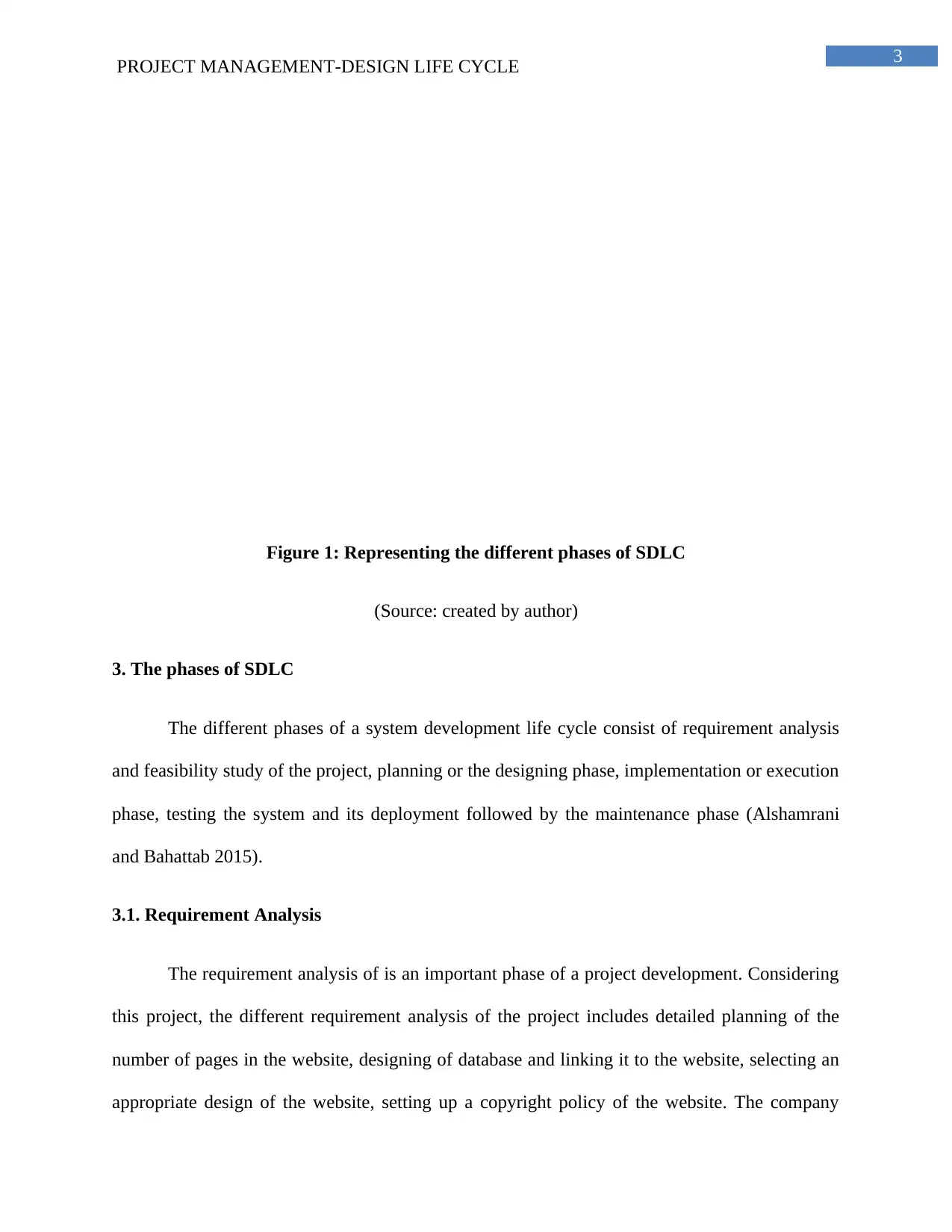
3
PROJECT MANAGEMENT-DESIGN LIFE CYCLE
Figure 1: Representing the different phases of SDLC
(Source: created by author)
3. The phases of SDLC
The different phases of a system development life cycle consist of requirement analysis
and feasibility study of the project, planning or the designing phase, implementation or execution
phase, testing the system and its deployment followed by the maintenance phase (Alshamrani
and Bahattab 2015).
3.1. Requirement Analysis
The requirement analysis of is an important phase of a project development. Considering
this project, the different requirement analysis of the project includes detailed planning of the
number of pages in the website, designing of database and linking it to the website, selecting an
appropriate design of the website, setting up a copyright policy of the website. The company
PROJECT MANAGEMENT-DESIGN LIFE CYCLE
Figure 1: Representing the different phases of SDLC
(Source: created by author)
3. The phases of SDLC
The different phases of a system development life cycle consist of requirement analysis
and feasibility study of the project, planning or the designing phase, implementation or execution
phase, testing the system and its deployment followed by the maintenance phase (Alshamrani
and Bahattab 2015).
3.1. Requirement Analysis
The requirement analysis of is an important phase of a project development. Considering
this project, the different requirement analysis of the project includes detailed planning of the
number of pages in the website, designing of database and linking it to the website, selecting an
appropriate design of the website, setting up a copyright policy of the website. The company
Paraphrase This Document
Need a fresh take? Get an instant paraphrase of this document with our AI Paraphraser
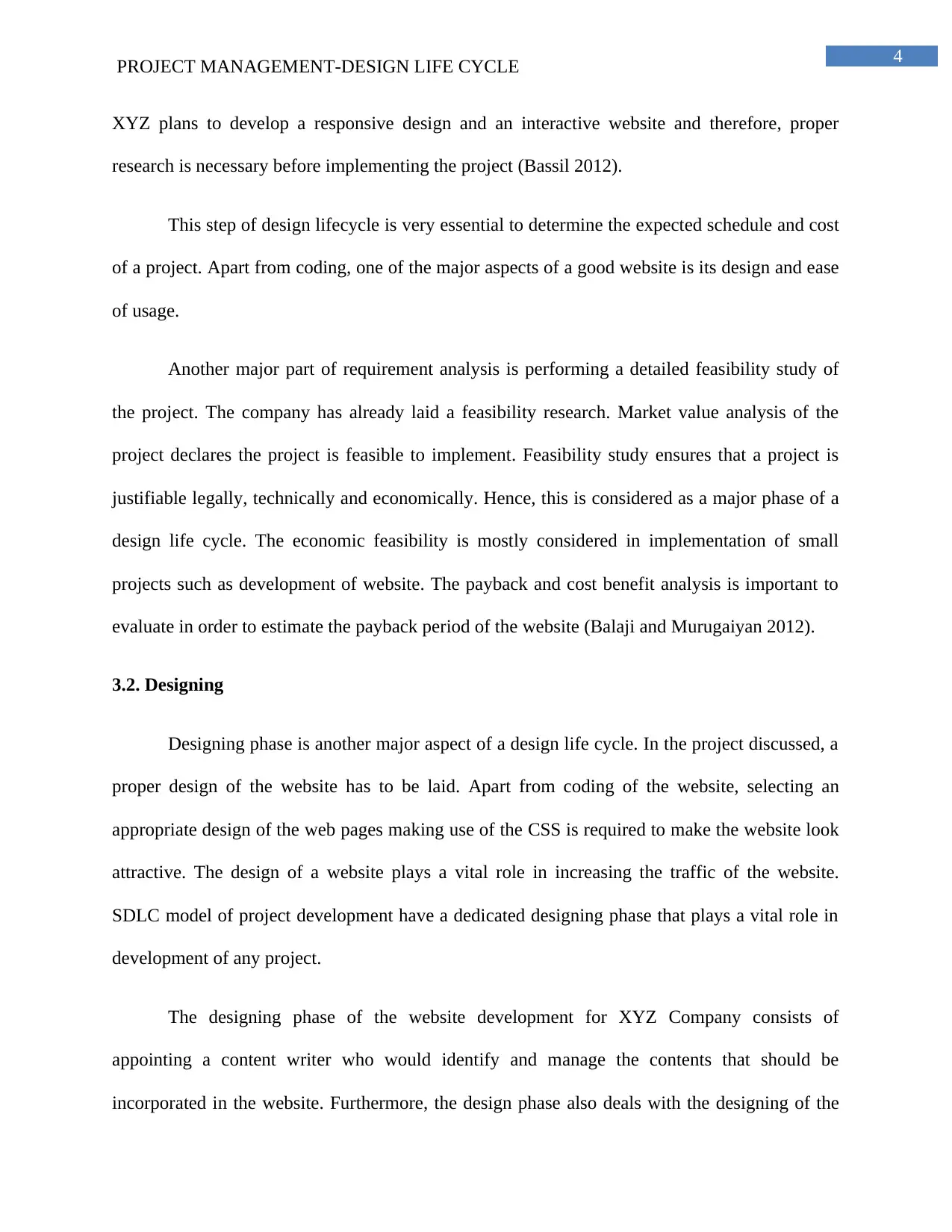
4
PROJECT MANAGEMENT-DESIGN LIFE CYCLE
XYZ plans to develop a responsive design and an interactive website and therefore, proper
research is necessary before implementing the project (Bassil 2012).
This step of design lifecycle is very essential to determine the expected schedule and cost
of a project. Apart from coding, one of the major aspects of a good website is its design and ease
of usage.
Another major part of requirement analysis is performing a detailed feasibility study of
the project. The company has already laid a feasibility research. Market value analysis of the
project declares the project is feasible to implement. Feasibility study ensures that a project is
justifiable legally, technically and economically. Hence, this is considered as a major phase of a
design life cycle. The economic feasibility is mostly considered in implementation of small
projects such as development of website. The payback and cost benefit analysis is important to
evaluate in order to estimate the payback period of the website (Balaji and Murugaiyan 2012).
3.2. Designing
Designing phase is another major aspect of a design life cycle. In the project discussed, a
proper design of the website has to be laid. Apart from coding of the website, selecting an
appropriate design of the web pages making use of the CSS is required to make the website look
attractive. The design of a website plays a vital role in increasing the traffic of the website.
SDLC model of project development have a dedicated designing phase that plays a vital role in
development of any project.
The designing phase of the website development for XYZ Company consists of
appointing a content writer who would identify and manage the contents that should be
incorporated in the website. Furthermore, the design phase also deals with the designing of the
PROJECT MANAGEMENT-DESIGN LIFE CYCLE
XYZ plans to develop a responsive design and an interactive website and therefore, proper
research is necessary before implementing the project (Bassil 2012).
This step of design lifecycle is very essential to determine the expected schedule and cost
of a project. Apart from coding, one of the major aspects of a good website is its design and ease
of usage.
Another major part of requirement analysis is performing a detailed feasibility study of
the project. The company has already laid a feasibility research. Market value analysis of the
project declares the project is feasible to implement. Feasibility study ensures that a project is
justifiable legally, technically and economically. Hence, this is considered as a major phase of a
design life cycle. The economic feasibility is mostly considered in implementation of small
projects such as development of website. The payback and cost benefit analysis is important to
evaluate in order to estimate the payback period of the website (Balaji and Murugaiyan 2012).
3.2. Designing
Designing phase is another major aspect of a design life cycle. In the project discussed, a
proper design of the website has to be laid. Apart from coding of the website, selecting an
appropriate design of the web pages making use of the CSS is required to make the website look
attractive. The design of a website plays a vital role in increasing the traffic of the website.
SDLC model of project development have a dedicated designing phase that plays a vital role in
development of any project.
The designing phase of the website development for XYZ Company consists of
appointing a content writer who would identify and manage the contents that should be
incorporated in the website. Furthermore, the design phase also deals with the designing of the
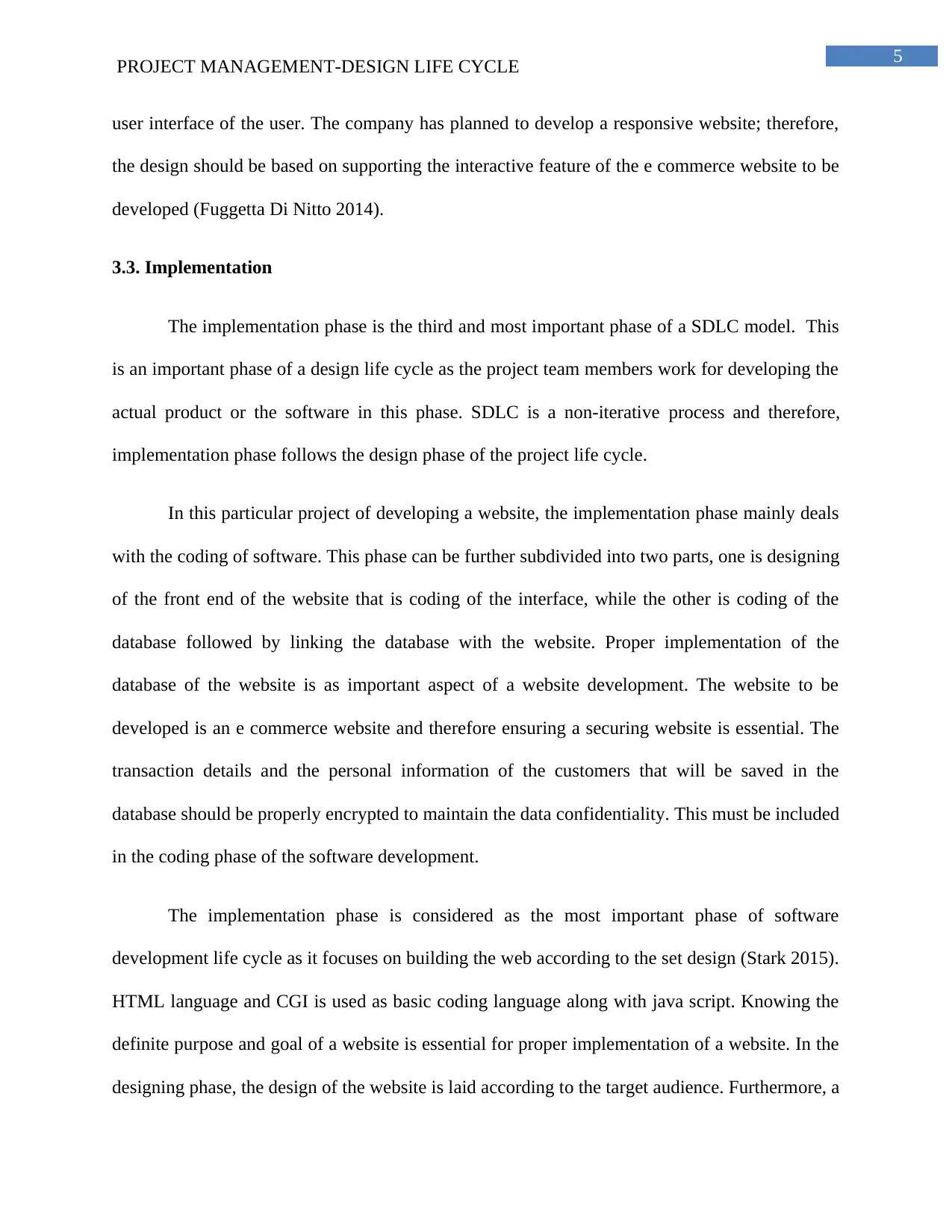
5
PROJECT MANAGEMENT-DESIGN LIFE CYCLE
user interface of the user. The company has planned to develop a responsive website; therefore,
the design should be based on supporting the interactive feature of the e commerce website to be
developed (Fuggetta Di Nitto 2014).
3.3. Implementation
The implementation phase is the third and most important phase of a SDLC model. This
is an important phase of a design life cycle as the project team members work for developing the
actual product or the software in this phase. SDLC is a non-iterative process and therefore,
implementation phase follows the design phase of the project life cycle.
In this particular project of developing a website, the implementation phase mainly deals
with the coding of software. This phase can be further subdivided into two parts, one is designing
of the front end of the website that is coding of the interface, while the other is coding of the
database followed by linking the database with the website. Proper implementation of the
database of the website is as important aspect of a website development. The website to be
developed is an e commerce website and therefore ensuring a securing website is essential. The
transaction details and the personal information of the customers that will be saved in the
database should be properly encrypted to maintain the data confidentiality. This must be included
in the coding phase of the software development.
The implementation phase is considered as the most important phase of software
development life cycle as it focuses on building the web according to the set design (Stark 2015).
HTML language and CGI is used as basic coding language along with java script. Knowing the
definite purpose and goal of a website is essential for proper implementation of a website. In the
designing phase, the design of the website is laid according to the target audience. Furthermore, a
PROJECT MANAGEMENT-DESIGN LIFE CYCLE
user interface of the user. The company has planned to develop a responsive website; therefore,
the design should be based on supporting the interactive feature of the e commerce website to be
developed (Fuggetta Di Nitto 2014).
3.3. Implementation
The implementation phase is the third and most important phase of a SDLC model. This
is an important phase of a design life cycle as the project team members work for developing the
actual product or the software in this phase. SDLC is a non-iterative process and therefore,
implementation phase follows the design phase of the project life cycle.
In this particular project of developing a website, the implementation phase mainly deals
with the coding of software. This phase can be further subdivided into two parts, one is designing
of the front end of the website that is coding of the interface, while the other is coding of the
database followed by linking the database with the website. Proper implementation of the
database of the website is as important aspect of a website development. The website to be
developed is an e commerce website and therefore ensuring a securing website is essential. The
transaction details and the personal information of the customers that will be saved in the
database should be properly encrypted to maintain the data confidentiality. This must be included
in the coding phase of the software development.
The implementation phase is considered as the most important phase of software
development life cycle as it focuses on building the web according to the set design (Stark 2015).
HTML language and CGI is used as basic coding language along with java script. Knowing the
definite purpose and goal of a website is essential for proper implementation of a website. In the
designing phase, the design of the website is laid according to the target audience. Furthermore, a
⊘ This is a preview!⊘
Do you want full access?
Subscribe today to unlock all pages.

Trusted by 1+ million students worldwide

6
PROJECT MANAGEMENT-DESIGN LIFE CYCLE
set goal is important to evaluate how the website is going to perform or whether it has any scope
of improvement in future. The knowledge about the target audience helps in designing and
developing the appropriate content (Barnes and Hunt 2013).
3.4. Testing
Implementation phase of the software development is followed by the testing phase in a
design life cycle. The SDLC approach discussed in this case study also deals with an extensive
testing phase of the software to unhide the bugs present in the system. The testing phase is one of
the major aspects of a design life cycle as it helps in eliminating the bugs from the system.
Software testing is generally required to point out the defects and errors that are made during the
development phases of the project. Testing is furthermore important to ensure the quality of the
product. Testing measures how effective, the performance of the software is and therefore, it is a
crucial step of any design life cycle. This phase of SDLC allows the coders or the developers to
check whether the code and the program working according to the set criteria (Lewis 2016).
In this project, all types of functional testing have been carried put in order to unveil the
bugs present in the system. These includes unit testing, integration testing and system testing
includes the white box and black box testing. The code developed was needed to be tested
against the requirements in order to ascertain whether the product is solving the needs that were
gathered during the requirement analysis phase.
3.5. Deployment
This phase is followed by the testing phase and includes delivery of a finished product to
the client. This phase of SDLC consist of beta testing that is required to identify the bugs that
might be still present in the system. If any bug is caught in this phase, the engineering team is at
PROJECT MANAGEMENT-DESIGN LIFE CYCLE
set goal is important to evaluate how the website is going to perform or whether it has any scope
of improvement in future. The knowledge about the target audience helps in designing and
developing the appropriate content (Barnes and Hunt 2013).
3.4. Testing
Implementation phase of the software development is followed by the testing phase in a
design life cycle. The SDLC approach discussed in this case study also deals with an extensive
testing phase of the software to unhide the bugs present in the system. The testing phase is one of
the major aspects of a design life cycle as it helps in eliminating the bugs from the system.
Software testing is generally required to point out the defects and errors that are made during the
development phases of the project. Testing is furthermore important to ensure the quality of the
product. Testing measures how effective, the performance of the software is and therefore, it is a
crucial step of any design life cycle. This phase of SDLC allows the coders or the developers to
check whether the code and the program working according to the set criteria (Lewis 2016).
In this project, all types of functional testing have been carried put in order to unveil the
bugs present in the system. These includes unit testing, integration testing and system testing
includes the white box and black box testing. The code developed was needed to be tested
against the requirements in order to ascertain whether the product is solving the needs that were
gathered during the requirement analysis phase.
3.5. Deployment
This phase is followed by the testing phase and includes delivery of a finished product to
the client. This phase of SDLC consist of beta testing that is required to identify the bugs that
might be still present in the system. If any bug is caught in this phase, the engineering team is at
Paraphrase This Document
Need a fresh take? Get an instant paraphrase of this document with our AI Paraphraser

7
PROJECT MANAGEMENT-DESIGN LIFE CYCLE
once reported about the bug so that the issue can be fixed. Once the engineering team resolves
the issues, the final deployment of the software can take place. The initial deployment phase of
the software includes a project review by the project management team to know about the views
of the customer (Model 2015). This phase of a design lifecycle model helps to enables the
product to be used in real environment generally by the end users of the product. However, there
are certain rules of the deployment phase that should be followed by the project team in order to
ensure the appropriate deployment of the code and technology. One of the major phases of
deployment is preparation and procedure phase where the project teams should generally install
the software and ensures proper installation. The project team members are responsible for
proper installation of the software and instruct the users about the working of the software in the
information technology environment (Sabale and Dani 2012). After the installation phase of the
software, the project team members implement the code and the program to different systems in
the location of deployment such as an organization. This is an extensive process since every
computer of the organization should be deployed with the software developed.
Another major functionality of the deployment phase of the software includes the client
sign off phase or transferring the ownership to the business owner. This indicates that after the
successful deployment of the software, the business owner will be responsible for the
maintenance of the system (Mishra and Dubey 2013).
In the project of development of an e commerce website for XYZ Company, the initial
deployment phase includes launching the website for performing the beta testing. Once the beta
testing is successfully completed and the identified bugs are removed, the final website
launching is carried out. The successful launching of the website marks the end of the
deployment phase of the SDLC model. In the end of the deployment phase, the project team
PROJECT MANAGEMENT-DESIGN LIFE CYCLE
once reported about the bug so that the issue can be fixed. Once the engineering team resolves
the issues, the final deployment of the software can take place. The initial deployment phase of
the software includes a project review by the project management team to know about the views
of the customer (Model 2015). This phase of a design lifecycle model helps to enables the
product to be used in real environment generally by the end users of the product. However, there
are certain rules of the deployment phase that should be followed by the project team in order to
ensure the appropriate deployment of the code and technology. One of the major phases of
deployment is preparation and procedure phase where the project teams should generally install
the software and ensures proper installation. The project team members are responsible for
proper installation of the software and instruct the users about the working of the software in the
information technology environment (Sabale and Dani 2012). After the installation phase of the
software, the project team members implement the code and the program to different systems in
the location of deployment such as an organization. This is an extensive process since every
computer of the organization should be deployed with the software developed.
Another major functionality of the deployment phase of the software includes the client
sign off phase or transferring the ownership to the business owner. This indicates that after the
successful deployment of the software, the business owner will be responsible for the
maintenance of the system (Mishra and Dubey 2013).
In the project of development of an e commerce website for XYZ Company, the initial
deployment phase includes launching the website for performing the beta testing. Once the beta
testing is successfully completed and the identified bugs are removed, the final website
launching is carried out. The successful launching of the website marks the end of the
deployment phase of the SDLC model. In the end of the deployment phase, the project team
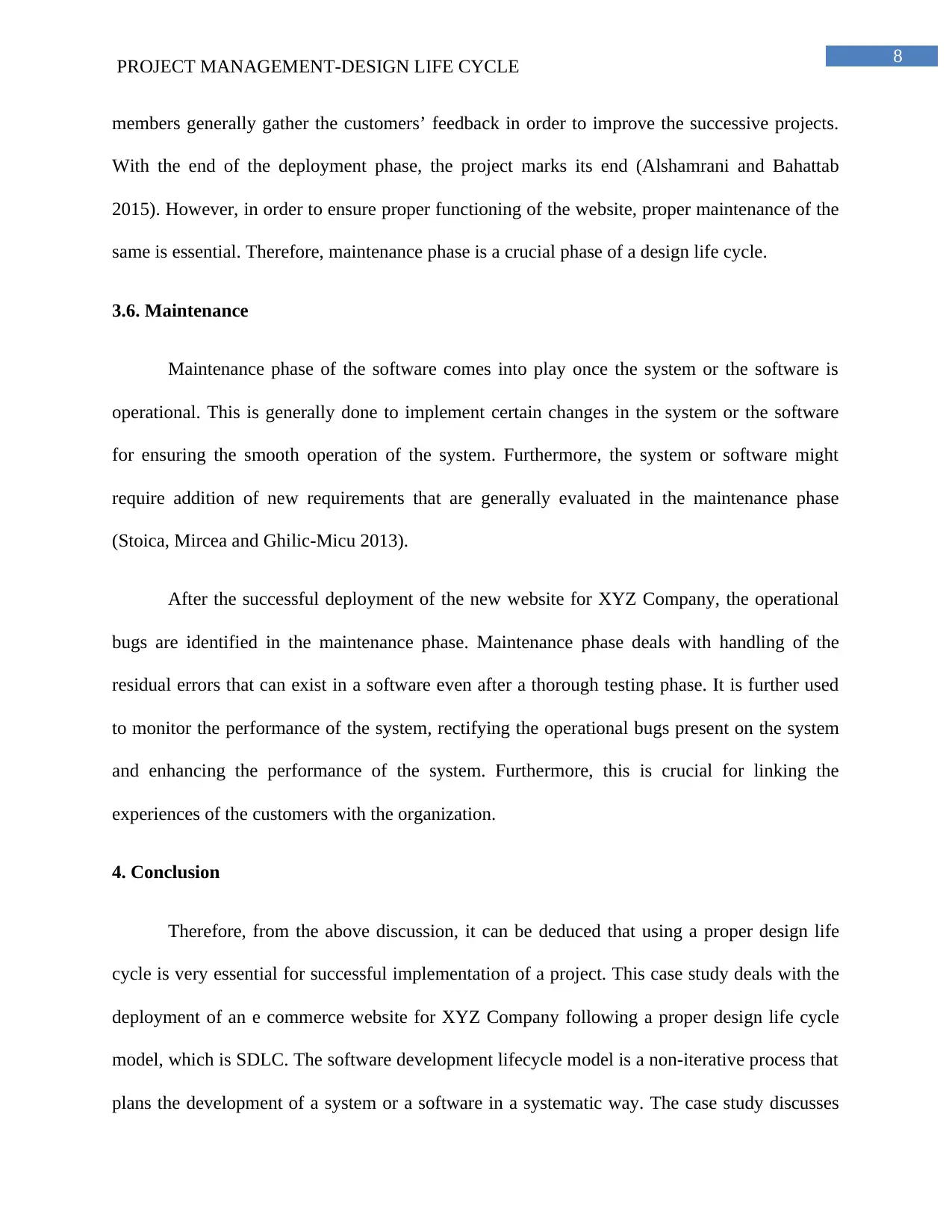
8
PROJECT MANAGEMENT-DESIGN LIFE CYCLE
members generally gather the customers’ feedback in order to improve the successive projects.
With the end of the deployment phase, the project marks its end (Alshamrani and Bahattab
2015). However, in order to ensure proper functioning of the website, proper maintenance of the
same is essential. Therefore, maintenance phase is a crucial phase of a design life cycle.
3.6. Maintenance
Maintenance phase of the software comes into play once the system or the software is
operational. This is generally done to implement certain changes in the system or the software
for ensuring the smooth operation of the system. Furthermore, the system or software might
require addition of new requirements that are generally evaluated in the maintenance phase
(Stoica, Mircea and Ghilic-Micu 2013).
After the successful deployment of the new website for XYZ Company, the operational
bugs are identified in the maintenance phase. Maintenance phase deals with handling of the
residual errors that can exist in a software even after a thorough testing phase. It is further used
to monitor the performance of the system, rectifying the operational bugs present on the system
and enhancing the performance of the system. Furthermore, this is crucial for linking the
experiences of the customers with the organization.
4. Conclusion
Therefore, from the above discussion, it can be deduced that using a proper design life
cycle is very essential for successful implementation of a project. This case study deals with the
deployment of an e commerce website for XYZ Company following a proper design life cycle
model, which is SDLC. The software development lifecycle model is a non-iterative process that
plans the development of a system or a software in a systematic way. The case study discusses
PROJECT MANAGEMENT-DESIGN LIFE CYCLE
members generally gather the customers’ feedback in order to improve the successive projects.
With the end of the deployment phase, the project marks its end (Alshamrani and Bahattab
2015). However, in order to ensure proper functioning of the website, proper maintenance of the
same is essential. Therefore, maintenance phase is a crucial phase of a design life cycle.
3.6. Maintenance
Maintenance phase of the software comes into play once the system or the software is
operational. This is generally done to implement certain changes in the system or the software
for ensuring the smooth operation of the system. Furthermore, the system or software might
require addition of new requirements that are generally evaluated in the maintenance phase
(Stoica, Mircea and Ghilic-Micu 2013).
After the successful deployment of the new website for XYZ Company, the operational
bugs are identified in the maintenance phase. Maintenance phase deals with handling of the
residual errors that can exist in a software even after a thorough testing phase. It is further used
to monitor the performance of the system, rectifying the operational bugs present on the system
and enhancing the performance of the system. Furthermore, this is crucial for linking the
experiences of the customers with the organization.
4. Conclusion
Therefore, from the above discussion, it can be deduced that using a proper design life
cycle is very essential for successful implementation of a project. This case study deals with the
deployment of an e commerce website for XYZ Company following a proper design life cycle
model, which is SDLC. The software development lifecycle model is a non-iterative process that
plans the development of a system or a software in a systematic way. The case study discusses
⊘ This is a preview!⊘
Do you want full access?
Subscribe today to unlock all pages.

Trusted by 1+ million students worldwide
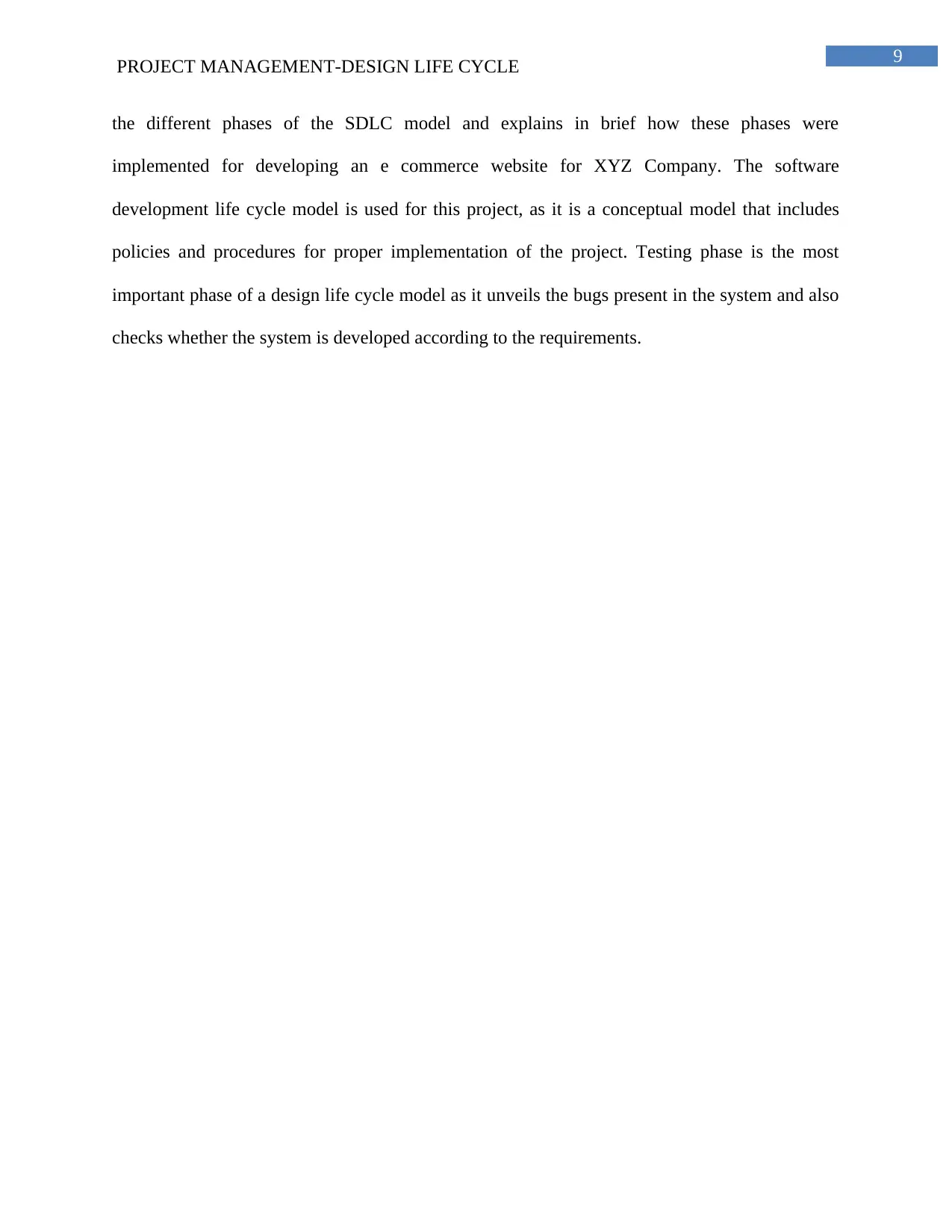
9
PROJECT MANAGEMENT-DESIGN LIFE CYCLE
the different phases of the SDLC model and explains in brief how these phases were
implemented for developing an e commerce website for XYZ Company. The software
development life cycle model is used for this project, as it is a conceptual model that includes
policies and procedures for proper implementation of the project. Testing phase is the most
important phase of a design life cycle model as it unveils the bugs present in the system and also
checks whether the system is developed according to the requirements.
PROJECT MANAGEMENT-DESIGN LIFE CYCLE
the different phases of the SDLC model and explains in brief how these phases were
implemented for developing an e commerce website for XYZ Company. The software
development life cycle model is used for this project, as it is a conceptual model that includes
policies and procedures for proper implementation of the project. Testing phase is the most
important phase of a design life cycle model as it unveils the bugs present in the system and also
checks whether the system is developed according to the requirements.
Paraphrase This Document
Need a fresh take? Get an instant paraphrase of this document with our AI Paraphraser
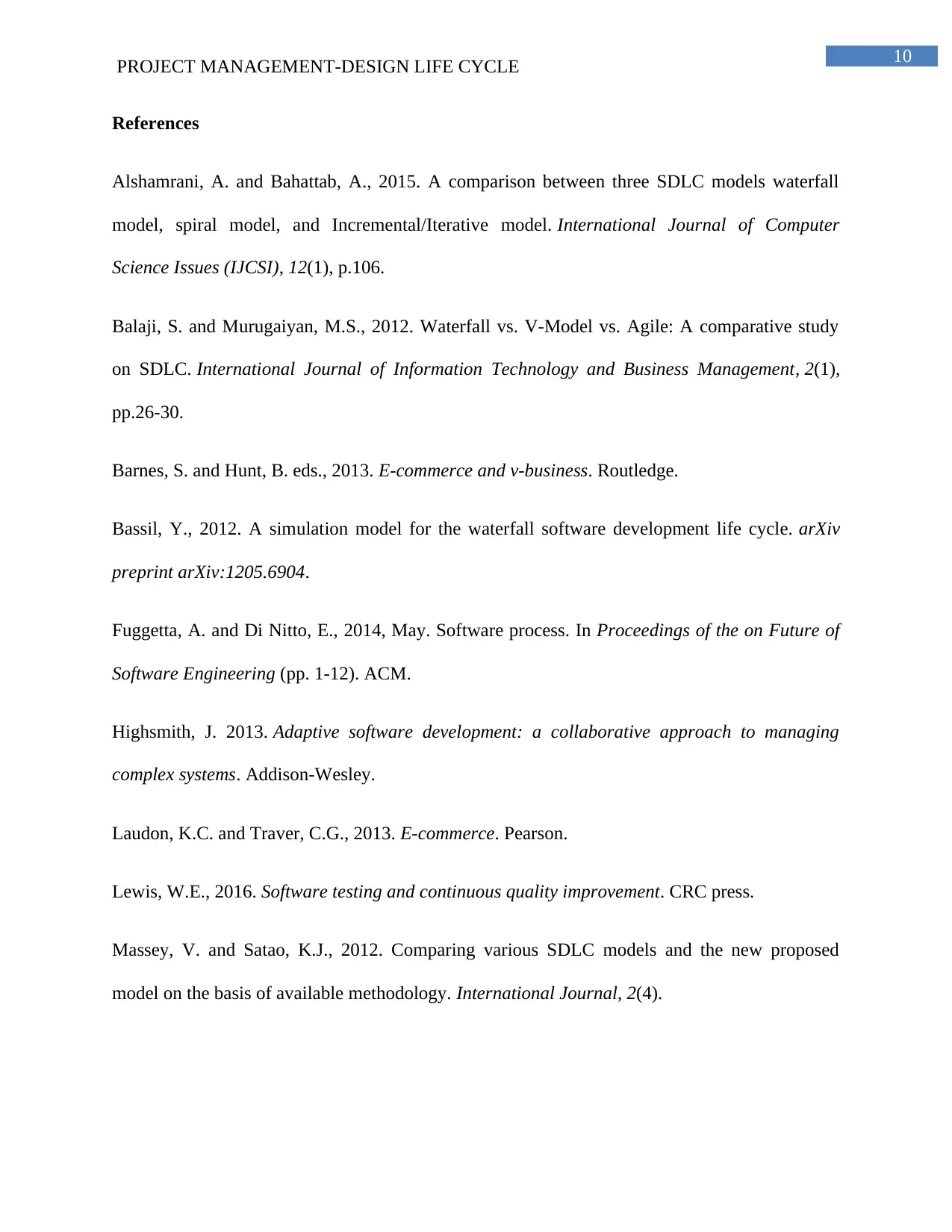
10
PROJECT MANAGEMENT-DESIGN LIFE CYCLE
References
Alshamrani, A. and Bahattab, A., 2015. A comparison between three SDLC models waterfall
model, spiral model, and Incremental/Iterative model. International Journal of Computer
Science Issues (IJCSI), 12(1), p.106.
Balaji, S. and Murugaiyan, M.S., 2012. Waterfall vs. V-Model vs. Agile: A comparative study
on SDLC. International Journal of Information Technology and Business Management, 2(1),
pp.26-30.
Barnes, S. and Hunt, B. eds., 2013. E-commerce and v-business. Routledge.
Bassil, Y., 2012. A simulation model for the waterfall software development life cycle. arXiv
preprint arXiv:1205.6904.
Fuggetta, A. and Di Nitto, E., 2014, May. Software process. In Proceedings of the on Future of
Software Engineering (pp. 1-12). ACM.
Highsmith, J. 2013. Adaptive software development: a collaborative approach to managing
complex systems. Addison-Wesley.
Laudon, K.C. and Traver, C.G., 2013. E-commerce. Pearson.
Lewis, W.E., 2016. Software testing and continuous quality improvement. CRC press.
Massey, V. and Satao, K.J., 2012. Comparing various SDLC models and the new proposed
model on the basis of available methodology. International Journal, 2(4).
PROJECT MANAGEMENT-DESIGN LIFE CYCLE
References
Alshamrani, A. and Bahattab, A., 2015. A comparison between three SDLC models waterfall
model, spiral model, and Incremental/Iterative model. International Journal of Computer
Science Issues (IJCSI), 12(1), p.106.
Balaji, S. and Murugaiyan, M.S., 2012. Waterfall vs. V-Model vs. Agile: A comparative study
on SDLC. International Journal of Information Technology and Business Management, 2(1),
pp.26-30.
Barnes, S. and Hunt, B. eds., 2013. E-commerce and v-business. Routledge.
Bassil, Y., 2012. A simulation model for the waterfall software development life cycle. arXiv
preprint arXiv:1205.6904.
Fuggetta, A. and Di Nitto, E., 2014, May. Software process. In Proceedings of the on Future of
Software Engineering (pp. 1-12). ACM.
Highsmith, J. 2013. Adaptive software development: a collaborative approach to managing
complex systems. Addison-Wesley.
Laudon, K.C. and Traver, C.G., 2013. E-commerce. Pearson.
Lewis, W.E., 2016. Software testing and continuous quality improvement. CRC press.
Massey, V. and Satao, K.J., 2012. Comparing various SDLC models and the new proposed
model on the basis of available methodology. International Journal, 2(4).
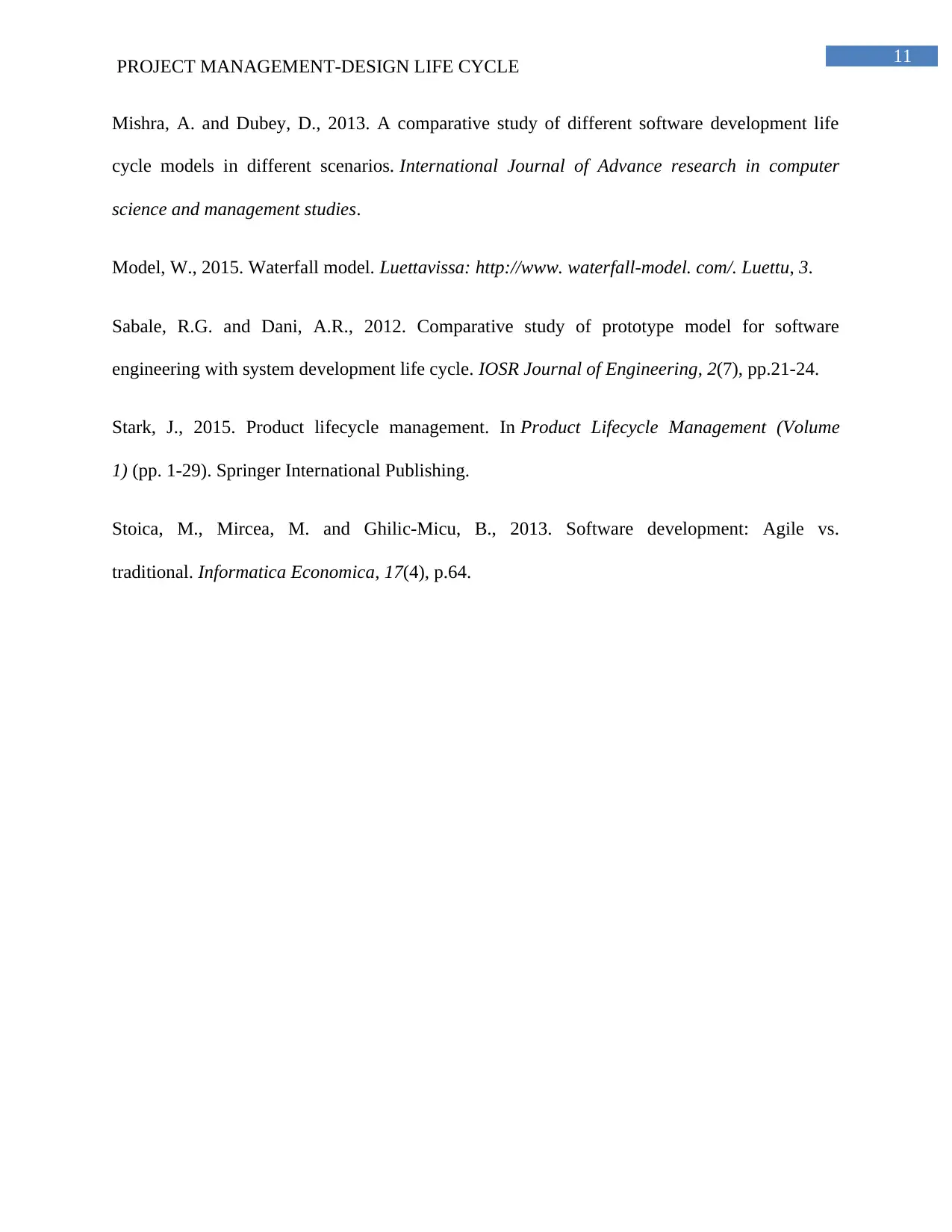
11
PROJECT MANAGEMENT-DESIGN LIFE CYCLE
Mishra, A. and Dubey, D., 2013. A comparative study of different software development life
cycle models in different scenarios. International Journal of Advance research in computer
science and management studies.
Model, W., 2015. Waterfall model. Luettavissa: http://www. waterfall-model. com/. Luettu, 3.
Sabale, R.G. and Dani, A.R., 2012. Comparative study of prototype model for software
engineering with system development life cycle. IOSR Journal of Engineering, 2(7), pp.21-24.
Stark, J., 2015. Product lifecycle management. In Product Lifecycle Management (Volume
1) (pp. 1-29). Springer International Publishing.
Stoica, M., Mircea, M. and Ghilic-Micu, B., 2013. Software development: Agile vs.
traditional. Informatica Economica, 17(4), p.64.
PROJECT MANAGEMENT-DESIGN LIFE CYCLE
Mishra, A. and Dubey, D., 2013. A comparative study of different software development life
cycle models in different scenarios. International Journal of Advance research in computer
science and management studies.
Model, W., 2015. Waterfall model. Luettavissa: http://www. waterfall-model. com/. Luettu, 3.
Sabale, R.G. and Dani, A.R., 2012. Comparative study of prototype model for software
engineering with system development life cycle. IOSR Journal of Engineering, 2(7), pp.21-24.
Stark, J., 2015. Product lifecycle management. In Product Lifecycle Management (Volume
1) (pp. 1-29). Springer International Publishing.
Stoica, M., Mircea, M. and Ghilic-Micu, B., 2013. Software development: Agile vs.
traditional. Informatica Economica, 17(4), p.64.
⊘ This is a preview!⊘
Do you want full access?
Subscribe today to unlock all pages.

Trusted by 1+ million students worldwide
1 out of 12
Related Documents
Your All-in-One AI-Powered Toolkit for Academic Success.
+13062052269
info@desklib.com
Available 24*7 on WhatsApp / Email
![[object Object]](/_next/static/media/star-bottom.7253800d.svg)
Unlock your academic potential
Copyright © 2020–2025 A2Z Services. All Rights Reserved. Developed and managed by ZUCOL.




